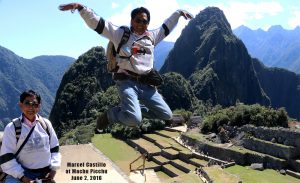
The Incas and their megalithic walls
(B – lesson on “BE” + Present Tense)
Traveling to Peru is an adventure requiring you to hike, appreciate the beauty of the mountains, drink coca tea, negotiate the altitude, the weather and the elements, and travel by boat over the highest lake in the world, Lake Titicaca. It is an adventure that utilizes all your senses into discovering the beauty at the summit of Macchu Pichu and the mystery behind the engineering of how the Incas build megalithic walls and sacred places using giant stones cut and placed together so perfectly that not even a paper can slip between the gigantic stones that it leaves one to wonder “How did the Incas do such a feat and what technology did they use to move such heavy stones.” The Inca people, the culture, and their way of living will challenge, intrigue, and involve you to explore and find out for yourself what the Inca culture is all about.

When I reached the very top of Macchu Pichu, I couldn’t help but jump with joy of accomplishing a dream come true. At the very top you feel like you are with God looking down at God’s creation. You breathe pure fresh air as the warm sun beats on your face and you are looking at the most spectacular view one can ever have at the very summit of a mountain. No wonder thousands of people from around the world make a trek here to experience the climb, the beauty, and the wonder of Macchu Pichu.

When you are at the very top of Macchu Pichu, you are surrounded by magnificent mountains, engulfed by a deep blue sky and scattered clouds, you feel the fresh air and the warm sun, you see the people below the mountains, you experience the history that made this place possible by the Incas, and you feel like you are one with God in the heavens and embracing the beautiful world that God created. It is an unbelievable experience. No wonder people from all over the world travel here to climb Macchu Pichu and see and experience for themselves what many have done already.
The verb “BE
Subject BE Complement
He/She/ It is here.
Abdul / the homework
We / you / they are helpful.
The classes /
The teachers
– The verb “Be” always agrees with the subject of the sentence.
– Short forms can be formed using “contractions for subject pronouns + BE
Full form Contracted Form Full form Contracted Form
I am I’m We are We’re
He is He’s You are You’re
She is She’s They are They’re
It is It’s
Negative forms of the verb “BE.”
Examples – Explanation
My mother is Filipino. She is not Mexican. Add “not” after the verb “BE” to make a sentence negative.
Marylyn is counselor. She is not a teacher.
My brothers are in the house. They are not outside.
A contraction can be made with the negative form of “BE.
– “I am” has only one form, the others have two.
Full form Contraction 1 Contraction 2 Complement
I am not – I’m not a policeman.
He is not He isn’t He’s not a teacher.
She is not She isn’t She’s not my cousin.
It is not. It isn’t It’s not my car.
We are not We aren’t We’re not at home.
You are not You aren’t You’re not happy.
They are not They aren’t They’re not from Korea.
Uses of the verb “BE”
Verb “Be” is used for many reason: It describes identifies, gives a location, or states a fact.
Examples: The apple is red. / The teacher is Mr. Geraldo. / The book is under the table
The Earth is round.
The verb “BE” is very useful at the beginning states of learning English, and it continues to be useful in all levels of English development.
Peru - Choosing the correct verb - on Peru article
The present tense is often used to “create questions” by using “Do/does + Subject + Verb?
Example –
- My brother enjoys playing the guitar. Question – Does your brother enjoy playing the guitar?
- You always study for the exam on weekends. Question – Do you always study for the exam on weekends?
The present tense is often used with questions words (Why, who, when, when, where, How) to create a question.
The pattern: Question word + do/does + subject
Example: 1) Why does your brother enjoy playing the guitar?
2) When do you study for the exam?
Practice for you using question words + present tense
Macchu Pichu
Uros Island
Ollantaytamabo
